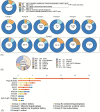Genetic spectrum of CAKUT and risk factors for kidney failure: a pediatric multicenter cohort study
- PMID: 36549658
- PMCID: PMC10468753
- DOI: 10.1093/ndt/gfac338
Genetic spectrum of CAKUT and risk factors for kidney failure: a pediatric multicenter cohort study
Abstract
Background: Congenital anomalies of the kidney and urinary tracts (CAKUT) are the leading cause of kidney failure in children with phenotypic and genotypic heterogeneity. Our objective was to describe the genetic spectrum and identify the risk factors for kidney failure in children with CAKUT.
Methods: Clinical and genetic data were derived from a multicenter network (Chinese Children Genetic Kidney Disease Database, CCGKDD) and the Chigene database. A total of 925 children with CAKUT who underwent genetic testing from 2014 to 2020 across China were studied. Data for a total of 584 children wereobtained from the CCGKDD, including longitudinal data regarding kidney function. The risk factors for kidney failure were determined by the Kaplan-Meier method and Cox proportional hazards models.
Results: A genetic diagnosis was established in 96 out of 925 (10.3%) children, including 72 (8%) with monogenic variants, 20 (2%) with copy number variants (CNVs), and 4 (0.4%)with major chromosomal anomalies. Patients with skeletal abnormalities were more likely to have large CNVs or abnormal karyotypes than monogenic variants. Eighty-two patients from the CCGKDD progressed to kidney failure at a median age of 13.0 (95% confidence interval, 12.4-13.6) years, and twenty-four were genetically diagnosed with variants of PAX2, TNXB, EYA1, HNF1B and GATA3 or the 48, XXYY karyotype. The multivariate analysis indicated that solitary kidney, posterior urethral valves, bilateral hypodysplasia, the presence of certain variants and premature birth were independent prognostic factors.
Conclusions: The genetic spectrum of CAKUT varies among different subphenotypes. The identified factors indicate areas that require special attention.
Keywords: children; congenital anomalies of the kidney and urinary tract; human genetics; kidney failure; risk factors.
© The Author(s) 2022. Published by Oxford University Press on behalf of the ERA.
Conflict of interest statement
The authors have no conflict of interest to declare.
Figures




References
-
- Harada R, Hamasaki Y, Okuda Yet al. . Epidemiology of pediatric chronic kidney disease/kidney failure: learning from registries and cohort studies. Pediatr Nephrol 2022;37:1215–29. - PubMed
-
- Shen Q, Fang X, Man Xet al. . Pediatric kidney transplantation in China: an analysis from the IPNA Global Kidney Replacement Therapy Registry. Pediatr Nephrol 2021;36:685–92. - PubMed
-
- Nicolaou N, Renkema KY, Bongers EMet al. . Genetic, environmental, and epigenetic factors involved in CAKUT. Nat Rev Nephrol 2015;11:720–31. - PubMed
LinkOut - more resources
Full Text Sources
Miscellaneous

